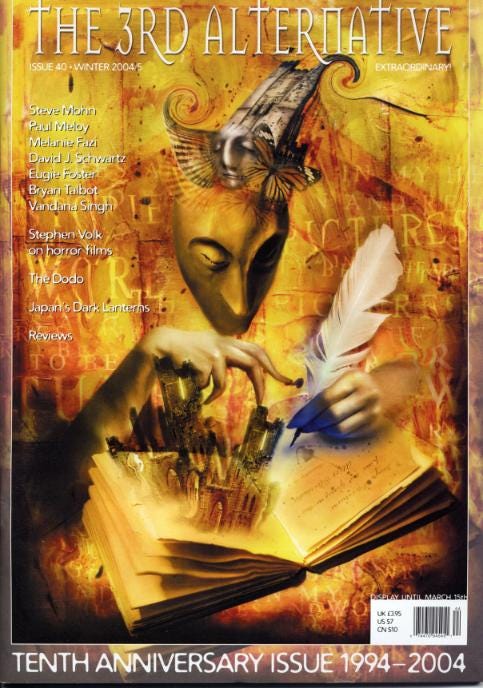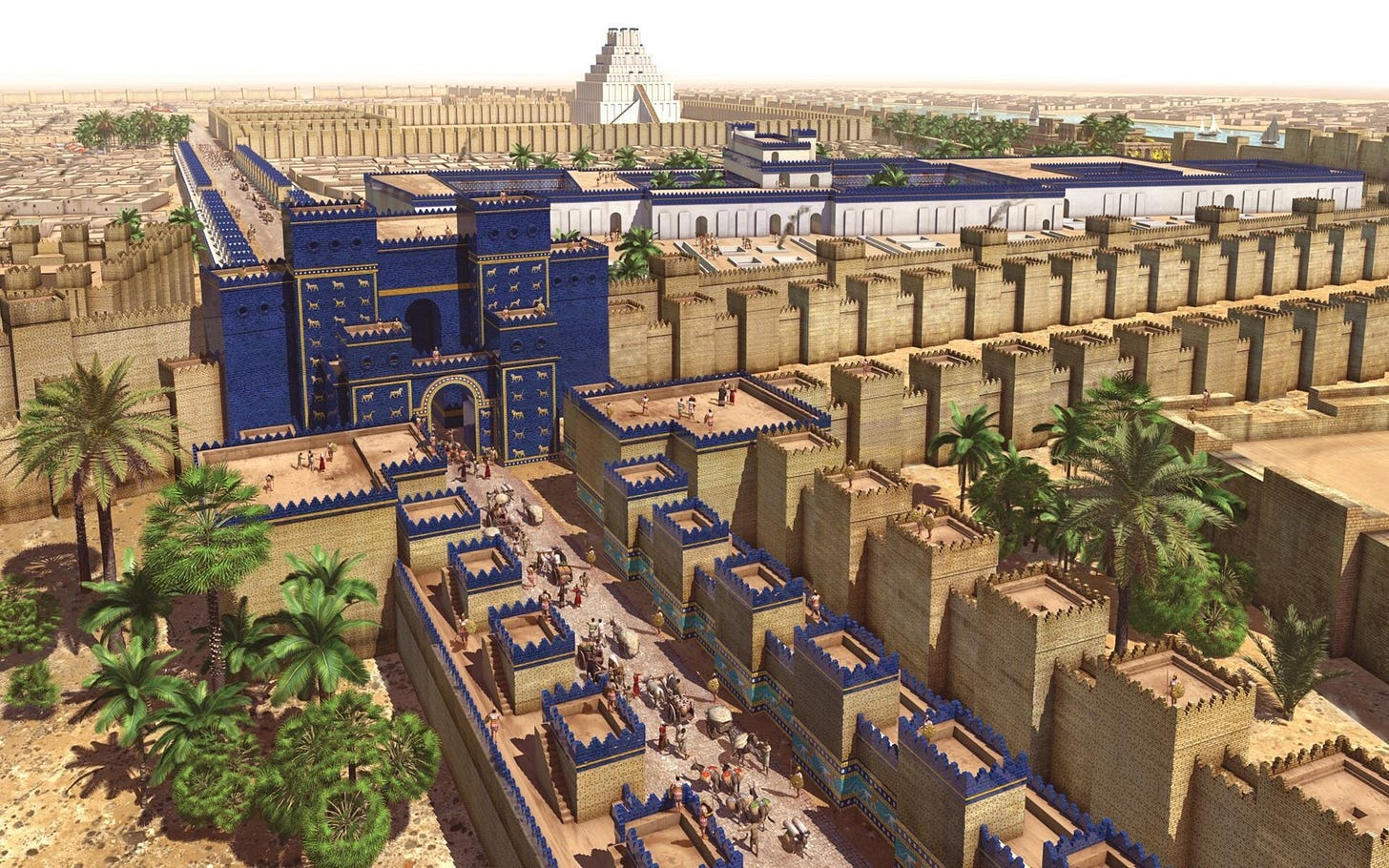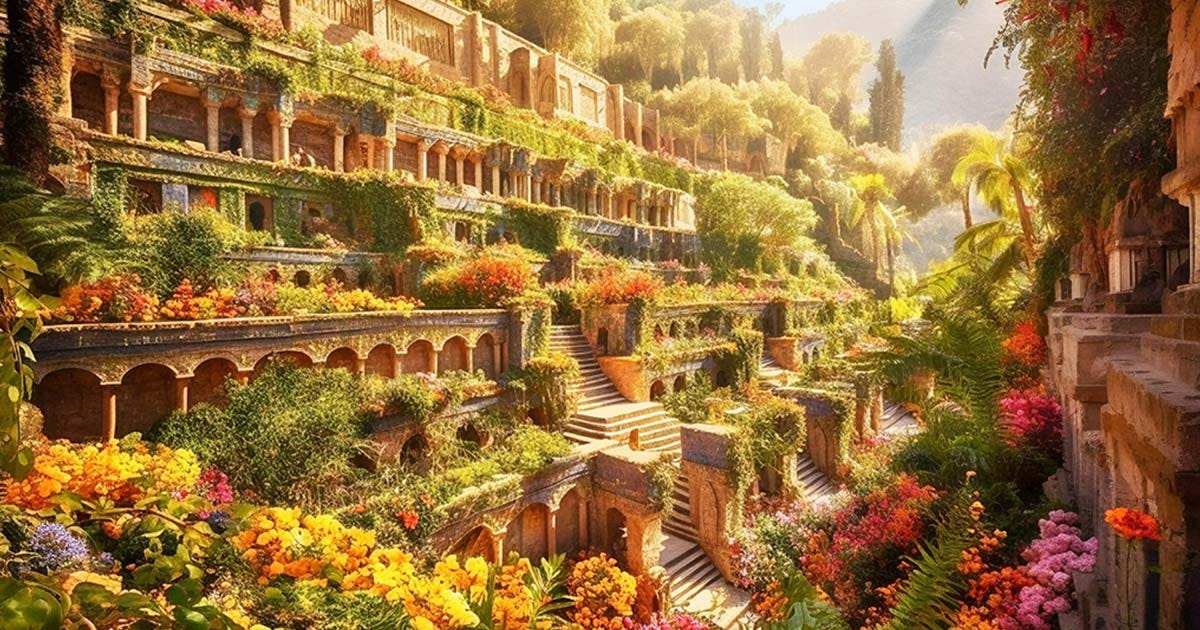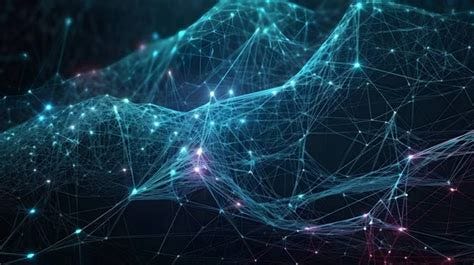The Replicant, the Mole & the Impostor, Part 36
Part 2—the conclusion—of a duology where a reality event held in a refugee camp on a Greek island unfolds in an utterly unexpected manner. There will be 50 parts. Chapter 9: April.

—In the Moodscape—
“Where are you taking us?” Idrissa says as he and Nyandeng follow Abeer and Ablam through a yet unused part of AR-space, which weirdly feels like they’re walking on solid ground as they cross a part of interplanetary space.
“To a special place,” Abeer says, “on which we worked very hard.”
“And that’s all we’re saying,” Ablam says, “as we want you to judge it without prejudice.”
“Why should we judge it?” Nyandeng says. “You can let your visitors make up their mind, and their feelings. At least, that’s what our moodscapes are supposed to do.”
“And you certainly don’t need us,” Idrissa says. “You’re free to develop your moodscape and market it. It’s a free world.”
“There will be private moodscapes, commercial ones, and ENE-approved ones,” Abeer says. “We’d like our moodscape to be the latter.”
“We try to construct our creation to the highest ethical standards,” Ablam says, “and your approval would acknowledge this.”
“We are not the queen and king of ENE,” Nyandeng says. “That’s the last thing we want. We see ourselves as enablers, as humble managers who recognize that the people they manage are much smarter than we.”
“Indeed,” Idrissa says. “We just want to create an environment that maximizes everybody’s talents, that enables people to achieve their full potential. If ENE truly works as we intend—and hope—then it’s the citizens who make the decisions.”
“Nevertheless, we would be honored if you visited our humble moodscape,” Abeer says.
“As we value your opinion highly,” Ablam says.
“Oh well, since you took the trouble to visit us in person,” Idrissa says, “we might as well take a look.”
“Indeed,” Nyandeng says. “Where do we find it?”
“It’s called Peaceable Autonomy,” Abeer says.
“I just sent you the login credentials,” Ablam says.
Nyandeng and Idrissa dive in the moment they receive them.
They’re in a slender yacht, sailing down a river through wetlands with lush green growth and lots of wildlife. Yellow-stalked, green-leaved reeds and light-green bulrush with their brown, sausage-shaped spikes on both sides, sago and shining pondweed. They spot white egrets and gulls with black beaks, black-winged stilts on their long, red legs, and multihued kingfishers. The odd otter, the rare desert hare trying to hide from jungle cats, grey wolves and red foxes. Rich and bio-diverse marshlands, unspoilt by pollution and climate change. The air is crisp and clear, the wetlands smell fresh as a daisy as the whole moodscape emanates an atmosphere of pureness and innocence.
They reach a huge city, which has walled itself off from the river. They berth at a fortress just north of the walled city—the Magnificent Metropolis—where they are led to The Way In. The Way In is the lane of processions, the broad street leading to the Lapis Lazuli Gate. One does not just enter the Magnificent Metropolis—as too much beauty might hurt you—one’s mind has to be gradually prepared for it.
Hence, The Way In, featuring on each side, outside-in:
· Nine perfectly square, brown-bricked towers with blue-painted battlements on top, where the parapets are stepped triangles rather than square openings;
· Eight bulwarks, topped with similar parapets, connecting the nine towers;
· Brick relief images of the Sun, Moon, and stars, stretching over the bottom of the nine towers and eight bulwarks;
· A line of lush palm trees carefully tended to be of exactly the same height and thickness;
· A row of lion statues hewed from the best marble, walking toward the Lapis Lazuli Gate;
The very street itself is red-bricked from the towers and bulwarks until just over the row of lions. The center of the street is a plain sand color.
The Lapis Lazuli Gate is resplendent with deepest purple, shiniest silver, and purest gold. It towers fourteen meters over them. Adorned with thirteen rows of glazed, bas-relief bricks of alternating fiery dragons and feisty auroch bulls. The two top bulwarks are painted: one with the sky constellations at dawn, and one with the sky constellations at dusk. Each centered with a bright celestial body: Mars to the left, Venus to the right. There are guards with bows and arrows on the parapets and guards with spears and shields at the street level. Yet nobody stops them—the login credentials Abeer and Ablam provided them must be of a high level—as they enter through the Lapis Lazuli Gate.
The inner metropolis is a madhouse dominated by four huge structures: The Library with its Suspended Gardens; The Presidential Palace; The Mosque; and The Tall Tower.
They decide to go to the Library, through its north entrance, first. Inside, the Library’s full of clay tablets, prisms, and Rassam cylinders—cuneiform cylinders with ten faces. At first glance, the tablets seem to have cuneiform inscriptions, but as one tries to decipher it, miracles happen. Other layers seem to emanate from them, superimposed symbols that seem as indecipherable as the cuneiform characters, yet, not quite side-by-side, more like side-over-side, they begin to make sense.
They tell legendary tales about gods and goddesses ruling humanity while manipulating and fighting among themselves, ultimately losing humanity’s faith so that only one God remained. They depict long epics of huge human empires rising and falling, of huge monuments being built and then abandoned, and of a single tower so high it almost reached God.
Leaving the Library from the south entrance they walk through—what might have been—one of the first parks in history, called the Suspended Gardens. They’re a mix of the cultural—pillared terraces, fountains, broad stairs, and plazas—and the natural—acacia, dwarf and date palm, pistachio trees, thorny shrubs, ferns, and blooming barberry. Sculptures of wild animals are interchanged with huge, potted plants.
The Suspended Gardens are refreshingly cool in the midday heat, a verdant oasis in an ochre desert metropolis. Many of the trees and plants are not native, and need quite a bit of water, which is delivered through small aqueducts in combination with Archimedes screws. Rumor has it that the Suspended Gardens are a labor of love from the President for her consort, who moved over here from a milder, wetter climate.
So the Presidential Palace seems like the next logical stop, but—unfortunately—the tour ends here, as the Presidential Palace, the mosque, and the Tall Tower are off-limits. “Not because you don’t have the right credentials, or because you’re not a Muslim,” Abeer says, “but because they’re not ready yet.”
“Several of our WIPs—” Ablam says, “Works In Progress.”
So they can only admire these three structures from outside and hear the rumors about them.
The Presidential Palace was originally an imperial one before the Bloodless Revolution turned its courtroom into the seat of Parliament.
The mosque replaced not one, but five temples—four smaller ones dedicated to minor deities and the main temple of the Star Goddess—as Islam established itself in the Magnificent Metropolis.
The Tall Tower is the center of controversy: should it be finished, or should it be destroyed? Is its aim—reaching the stars—the height of mortal folly, or the pinnacle of human ingenuity?
As Nyandeng and Idrissa are pondering the latter, they are lifted out of the moodscape. As they take off their AR-gear, they’re eyeing Abeer and Ablam again in their private room somewhere in the renovated Chorió.
“What was that?” Nyandeng says. “You’re crowdsourcing a Middle Eastern Paradise?”
“As the saying goes,” Idrissa says, “be careful what you wish for.”
“We don’t know,” Abeer says. “We started this to get our minds away from all the trauma, all the horrible things that kept plaguing our memories.”
“And it went so well,” Ablam says, “that we got carried away.”
“We didn’t have a long-term plan when we started this moodscape,” Abeer says. “It just happened.”
“And it kept getting bigger and bigger as we let our imagination roam,” Ablam says, “and now we want to share it with like-minded souls.”
“Is it still a prototype?” Idrissa asks.
“Well, I suppose so,” Abeer says.
“This is a moodscape run by only two people?” Idrissa says. “That’s impressive, to say the least.”
“I’d go as far as saying that I didn’t know that was possible,” Nyandeng says. “A great achievement.”
“We have given access to a few people we really trust,” Ablam says. “We call them our beta-testers.”
“But those are less than a dozen,” Abeer says. “We’d also like to know if this one is ready for more general access.”
“I—” Idrissa starts, then corrects himself as he looks at Nyandeng. “Well, we think it is better to establish your moodscape with, well, a sufficient amount of kindred souls before you open it up to complete strangers.”
“Like what we are doing with ENE,” Nyandeng says. “Our Citizen Test functions like a two-edged sword: on the one hand, we’d like to welcome as many people as possible, but on the other hand, we must make sure we don’t accidentally let the wrong ones in.”
“No racists or bigots, no fascists or people with dictatorial tendencies,” Idrissa says, “no torturers, no rapists, no harassers, sexual or otherwise. The list goes on.”
“This is why we are wondering if we can have your approval,” Ablam says, “so that only ENE citizens can access it.”
“It would save us from the trouble of trying to pre-select potential users,” Abeer says, “so we can concentrate on improving our moodscape.”
“And I don’t think we’d be much good at filtering out the wrong ones,” Ablam says.
“Well, you will still need to,” Nyandeng says, “as this is a predominantly Middle Eastern, Islamic moodscape. There are plenty of non-Islam, non-Middle Eastern citizens, and I suspect they may not be the right users—at least not until you’ve firmly established your moodscape, scaled it up sufficiently.”
“I suppose we could open the prototype stage to Islamic people only,” Abeer says, “by simply asking them?”
“Then how would we know they’re not lying?” Ablam says, then looks at Nyandeng and Idrissa. “Is there a way?”
“A moodscape as a lie detector?” Idrissa muses. “I suppose it’s possible if you ask the questions when most people are logged in, and witnessing that test.”
“A jury of one’s peers that judges via the ENE moodscape,” Nyandeng says. “It’s one of the many things we’re working on.”
“In combination with judges that are as impartial as possible,” Idrissa says. “Which is where a replicant-type AI might fit in.”
“It’s a bit like the mind/body duality,” Nyandeng says, “as neuroscientists increasingly find that the mind housed in our brains is inseparable from the body.”
“One telling example,” Idrissa says, “is sleep. Animals and people die—after a number of days—when they don’t sleep. Several theories propose that sleep is necessary to clean the neurons, to determine which memories go long term or remain short term, to maintain the body’s hormone balance, or for cell healing and repair.”
“Which can all be true, more or less,” Nyandeng says, “but we traced one area of research that probably gives the answer: it manifests in the gut.”
“What eventually kills sleep-deprived animals—and probably humans—is the accumulation of a specific type of molecule, called reactive oxygen species (ROS), in the gut,” Idrissa says, “which are normally produced by our respiration process. Now during sleep, antioxidant enzymes sweep up these ROS molecules, neutralizing them. If left unchecked, then ROS molecules rip electrons away from DNA, protein and lipids, and if that oxidative damage reaches a certain level, then death sets in.”
“In experiments with fruit flies, they gave the sleep-deprived flies anti-oxidants,” Nyandeng says, “but that would only save the flies if the anti-oxidants were introduced in the gut, not when they were introduced in the nervous system.”
“Which is one synergetic connection between the gut and the brain nobody was aware of,” Idrissa says. “Dog knows how many more there are.”
“That’s why we’re sanguine to add people’s gut feelings into the mix in our ENE moodscape,” Nyandeng says. “There’s more going on there than meets the eye. We want to use those unidentified synergies, not exclude them.”
“Now we’re digressing,” Idrissa says, “but this is one of the things we hope to develop in the ENE: a governing entity that—while constantly growing and evolving—adds up to more than the sum of its parts.”
“Such synergies are everywhere,” Nyandeng says. “In physics—quantum coherence, strange attractors, phase transitions—in ecosystems—symbiosis, co-evolution, reciprocal altruism—and deep within our bodies—sleep deprivation mechanism, immune system, gut flora—to give just a few examples.”
“On top of that, we want to avoid the moodscapes becoming like neural networks,” Idrissa says, “as we’d like to know how they work the way they work, how they process all that data. As far as possible.”
“In any case, I don’t think it’s a problem if ENE—and ENE is more than just the two of us, so there needs to be an approval process, which we now need to work out—will acknowledge your moodscape,” Nyandeng says. “Just give us some time.”
“As we do have a lot on our plates already,” Idrissa says.
“Thank you,” Abeer says, “because we hope to do so much more with our moodscape.”
“Maybe a portal to gentle healing,” Ablam says.
“Would you use it for that?” Abeer wonders, caught somewhat off guard.
“I spent half my life suffering because I married the wrong husband,” Ablam says, the memories of his abuse still painful after all this time, “and now I want to be sure that I spend the rest of my days with the right man.”
“I sympathize,” Nyandeng says, “and with the right man—”
“Person,” Idrissa insists.
“Kindred soul,” Nyandeng continues, “you will love them the more you know them.” She gently squeezes Idrissa’s shoulder.
“Finally, before we go,” Abeer says, “thanks for letting us become ENE citizens. Especially as nobody knows how an asylum request will work out.”
“Because, with ENE, wherever they send us—some country in Europe, or back to Turkey—” Ablam says.
“We’ll always be home, in the most important way that matters,” Abeer says.
“Well, thank you for that,” Nyandeng says. “But we wish to go further.”
“Just keep us informed of whatever decision they make about your asylum request,” Idrissa says, “as there might be a third option.”

Support this writer:
Like this post!
Re-stack it using the ♻️ button below!
Share this post on Substack and other social media sites:
Join my mailing list:
Author’s note: I feel a bit like Fish when recording the Clutching at Straws album; that is, I’m doing my very best to make this particular project work, yet I need some rest after this. Urgently.
Fish left Marillion after the Clutching at Straws tour—overworked, overtired, pushed beyond his limits by a manager after which he eventually started a solo career—while Marillion had no choice but to replace him with another singer: Steve Hogarth. Both Marillion and Fish had some commercial success after that, although neither—IMHO—ever reached to the artistic heights of the Fugazi/Mispaced Childhood/Clutching at Straws era. YMMV.
I’m exhausted—artistically more than physically. I am taking action, as will be announced in early 2025. Anyway, many thanks for reading, many thanks for supporting me, and if you could spread the word, that would be highly appreciated!







